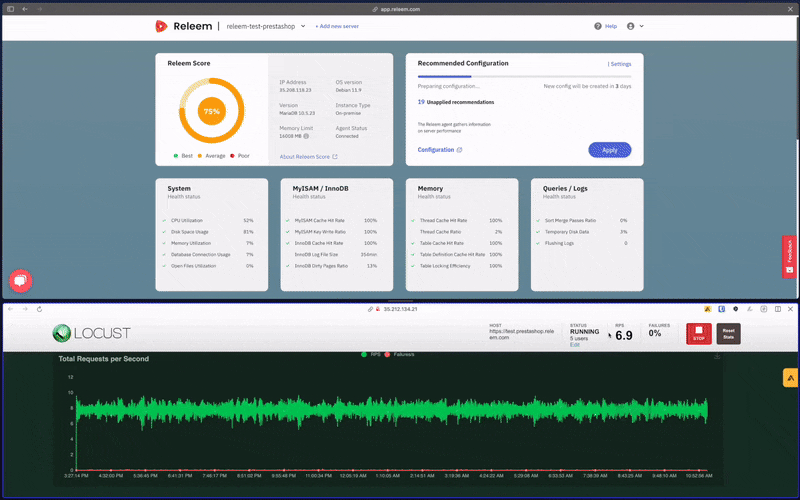
PrestaShop is a specialized, free, and open-source e-commerce platform developed in PHP, aimed at providing businesses, from startups to large enterprises, with the infrastructure to launch, manage, and scale their online stores.
Offering a rich selection of customizable themes and a comprehensive suite of e-commerce features, PrestaShop supports a wide array of functionalities, such as product management, secure payments, shipping, and inventory management, directly out of the box.
Improving application performance with tuning is best achieved with a comprehensive approach that addresses the following areas:
Many experienced PrestaShop developers don’t look at database performance tuning as an opportunity to improve the performance of their apps because they know little about this domain. They spend a lot of time optimizing the codebase, but it reaches a point where it no longer brings a valuable result for the time and energy invested. Our research on how MySQL tuning positively affects the performance of popular open-source web applications is aimed at showcasing this fact to users.
The version of PrestaShop being utilized for testing is 8.1.2, which is specifically optimized for use with PHP 8.1. Detailed guidance on installing this version of PrestaShop can be found in the official documentation.
We installed the PrestaShop with the default installation with demo data, export all demo products and import it as a new products multiples times, then we install multiples languages for the e-commerce.
Our test duration was 2 days. To handle this longer testing period, we switched from BlazeMeter (max test duration of 20 minutes) to Locust, an open-source load-testing tool.
We used:
GCP Compute Engine instance c2-standard-4, equipped with Debian Bullseye for the operating system, Apache for the web server, and MariaDB 10.5 in its default configuration with a database size of 1GB.
Tuned Configuration for Prestashop:
[mysqld] innodb_change_buffering=none innodb_change_buffer_max_size=25 innodb_adaptive_flushing_lwm=25.000000 innodb_max_dirty_pages_pct=70.000000 innodb_autoextend_increment=48 thread_stack=299008 transaction_prealloc_size=8192 thread_cache_size=172 max_connections=172 query_cache_type=1 query_cache_size=134217728 query_cache_limit=33554432 query_cache_min_res_unit=4096 key_buffer_size=8388608 max_heap_table_size=16777216 tmp_table_size=16777216 innodb_buffer_pool_size=3355443200 innodb_log_file_size=25165824 innodb_file_per_table=1 sort_buffer_size=2097152 read_rnd_buffer_size=262144 bulk_insert_buffer_size=8388608 myisam_sort_buffer_size=8388608 innodb_buffer_pool_chunk_size=134217728 join_buffer_size=8388608 table_open_cache=2048 table_definition_cache=512 innodb_flush_log_at_trx_commit=1 innodb_log_buffer_size=16777216 innodb_write_io_threads=4 innodb_read_io_threads=4 innodb_flush_method=O_DIRECT innodb_thread_concurrency=0 optimizer_search_depth=0 innodb_purge_threads=4 thread_handling=one-thread-per-connection thread_pool_size=6
The performance evaluation of PrestaShop revealed significant enhancements post-optimization.
Notably, the response time experienced a remarkable decrease from 610ms to 370ms, marking a 39% improvement. Similarly, the website’s ability to handle requests surged by 50%, from 8 to 12 requests per second.
CPU utilization saw a reduction, moving from full capacity at 100% down to 90%, a 10% decrease in load. Most impressively, MySQL’s query processing capability jumped from 5078 to 7816 queries per second, a substantial increase of 53%.
We recorded screencast to show the impact on Response Time after applying recommended MySQL configuration.


Graphs of the testing results are available below:

Response Times (ms), Prestashop Tuned MySQL Configuration vs Default

CPU Utilization (%), PrestaShop Tuned MySQL Configuration vs Default

Queries Per Seconds, Prestashop Tuned MySQL Configuration vs Default
In setting up our test environment, we collaborated closely with Giuseppe Pompeo, CEO of Multiservicios Austral. Giuseppe’s firm is at the forefront of digital services in Chile, particularly known for its expertise in e-commerce through PrestaShop. Their team, recognized and certified by PrestaShop, has been delivering specialized and professional services in this field for over six years.
Giuseppe’s involvement was crucial in getting our server ready, launching our website, and populating it with initial data. His vast experience with cloud infrastructure and a keen focus on optimizing e-commerce platforms like PrestaShop played a significant role in ensuring our tests ran smoothly. We’re immensely thankful for the knowledge and efficiency Giuseppe brought to our project.
Our testing procedure, using PrestaShop, showed improvements in Response Time (Latency), CPU Utilization, and Queries per second after configuring the database server configuration.
Responce Time (Latency) dropped between 39%, while CPU Utilization fell 10%. Queries per second increased PrestaShop by 53%. Requests per Second to Website 50%.
With this research, we hope to showcase the value of MySQL tuning as a means to improve the performance of PrestaShop applications and encourage PrestaShop users to consider this practice when optimizing the performance of their websites.
Using tools like Releem, databases can be quickly and easily configured for optimal performance, reducing the burden on software development teams.
The above is the detailed content of How MySQL Tuning Can Improve PrestaShop Performance. For more information, please follow other related articles on the PHP Chinese website!
 Solution to Google Chrome not working
Solution to Google Chrome not working
 The difference between header files and source files
The difference between header files and source files
 cdn server security protection measures
cdn server security protection measures
 Introduction to the location of win10 control panel
Introduction to the location of win10 control panel
 virtual digital currency
virtual digital currency
 sort sorting function usage
sort sorting function usage
 Summary of java basic knowledge
Summary of java basic knowledge
 How to delete a directory in LINUX
How to delete a directory in LINUX




